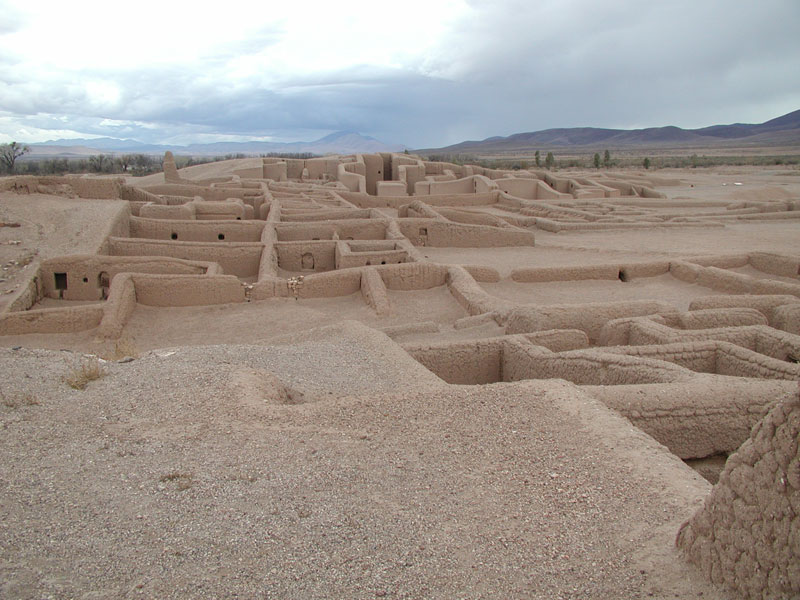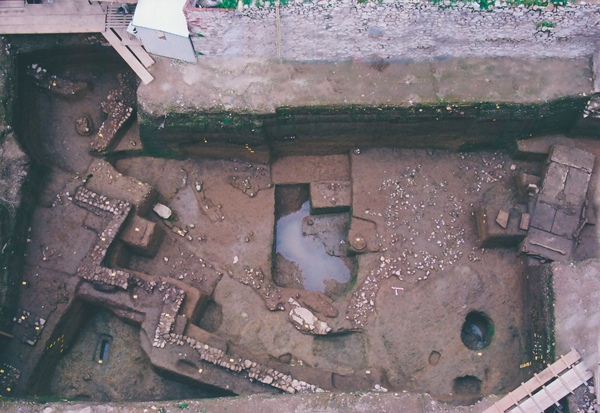On January 25, 2011, tens of thousands of protestors flooded Cairo's Tahrir Square, demanding the end of President Hosni Mubarak's regime. As the "day of revolt" filled the streets of Cairo and other cities with tear gas and flying stones, a team of archaeologists led by Susanne Bickel of the University of Basel in Switzerland was about to make one of the most significant discoveries in the Valley of the Kings in almost a century.
The valley lies on the west bank of the Nile, opposite what was once Egypt's spiritual center—the city of Thebes, now known as Luxor. The valley was the final resting place of the pharaohs and aristocracy beginning in the New Kingdom period (1539 - 1069 B.C.), when Egyptian wealth and power were at a high point. Dozens of tombs were cut into the valley's walls, but most of them were eventually looted. It was in this place that the Basel team came across what they initially believed to be an unremarkable find.
At the southeastern end of the valley they discovered three sides of a man-made stone rim surrounding an area of about three-and-a-half by five feet. The archaeologists suspected that it was just the top of an abandoned shaft. But, because of the uncertainty created by Egypt's political revolution, they covered the stone rim with an iron door while they informed the authorities and applied for an official permit to excavate.
A year later, just before the first anniversary of the revolution, Bickel returned with a team of two dozen people, including field director Elina Paulin-Grothe of the University of Basel, Egyptian inspector Ali Reda, and local workmen. They started clearing the sand and gravel out of the shaft. Eight feet down, they came upon the upper edge of a door blocked by large stones. At the bottom of the shaft they found fragments of pottery made from Nile silt and pieces of plaster, a material commonly used to seal tomb entrances. Those plaster pieces, together with the age of other nearby sites, were the first sign that the shaft might actually be a tomb dating to between 1539 and 1292 B.C., Egypt's Eighteenth Dynasty. The large stones appeared to have been added later.
Although stones blocked the entrance, there was a hole just large enough to admit a small digital camera. Bickel, Paulin- Grothe, and the chief of the Egyptian workmen each took turns lying on the ground, head pressed against the shaft wall, one arm through the hole, snapping pictures. The surprising images revealed a small rock-cut chamber measuring 13 by 8.5 feet, filled to within three feet of the ceiling with debris, leaving little doubt they had found a tomb. On top of the debris rested a dusty black coffin carved from sycamore wood and decorated with large yellow hieroglyphs on its sides and top. "I've never found a coffin in as good condition before," Bickel says.
The hieroglyphs describe the tomb's occupant, named Nehemes-Bastet, as a "lady" of the upper class and "chantress [shemayet] of Amun," whose father was a priest in the temple complex of Karnak in Thebes. The coffin's color and hieroglyphs match a style that dates to between 945 and 715 B.C., at least 350 years after the tomb was built. The coffin shows that the burial chamber had been reused, a common practice at the time.
The only other artifact dating to the same period as the coffin was a wooden stele, slightly smaller than an iPad, painted with a prayer to provide for her in the afterlife, and an image that is believed to be of Nehemes-Bastet in front of the seated sun god Amun. The white, green, yellow, and red paints hadn't faded a bit. Bickel says, "It could have been taken from a storeroom yesterday." The rubble that filled the chamber held the remnants of the original Eighteenth Dynasty burial, she adds, including pottery, wood fragments, and parts of the unwrapped and dismembered mummy who first occupied the tomb. It also must be noted that before the discovery of Nehemes-Bastet's, the last unlooted tomb found in the valley was the famous burial of Tutankhamun, discovered in 1922 by Howard Carter.

People have been claiming there was nothing new left to find in the Valley of the Kings for almost as long as they have been digging there. The Venetian antiquarian Giovanni Belzoni believed he had emptied the last of the valley's tombs during his 1817 expedition. Theodore Davis, who excavated there a century later, came to a similar conclusion—right before Tutankhamun's burial was found. Of course, other discoveries have been made in the valley. In 1995, a team led by Kent Weeks, now retired from the American University in Cairo, was investigating a tomb used by the family of Pharaoh Rameses II.* They found previously unknown corridors, leading to the resting place of Rameses II's sons, which extended to more than 121 rooms. Unfortunately, the rooms had been looted in antiquity and damaged by flash floods. In 2005, a team led by Otto Schaden of the Amenmesse Project discovered an unlooted chamber, which held seven coffins and 28 jars containing mummification materials. The chamber, however, contained no bodies, so it is unlikely that it was a tomb.
Before Bickel's team could take Nehemes-Bastet's coffin out of the burial chamber for further study, they had to open it to make sure that nothing inside would be damaged when it was moved. It took a professional restorer a day to remove the nails that held the lid closed. Inspector Ali Reda and Mohammed el-Bialy, chief inspector of antiquities of Upper Egypt, joined Bickel and Paulin-Grothe for the opening. Inside they found a carefully wrapped female mummy, about five feet tall. It was blackened all over—and stuck to the bottom of the coffin—by a sticky fruit-based syrup used in the mummification process.
Even in the short time since its discovery, the tomb is already providing intriguing insights into the life of the woman who was buried there. The time of Nehemes-Bastet's burial (sometime between 945 and 715 B.C.) was long after Egypt had reached the peak of its power and influence. The Great Pyramid was more than 1,500 years old, and the prosperous days of the New Kingdom were gone. Nehemes- Bastet lived during the Third Intermediate Period, a time when Egypt was split by intermittent wars between the pharaohs in Tanis and the high priests of Amun in Thebes, who rivaled the traditional rulers in wealth and power. "It must have been a pretty unsettling period," says Emily Teeter, an Egyptologist and research assistant at the Oriental Institute of the University of Chicago. "There was fighting among these factions around her time."
"It's interesting that in this period even a wealthy girl was buried with quite simple things," Bickel says, comparing Nehemes-Bastet's coffin and stele with the elaborate pottery, furniture, and food found in earlier tombs. "Her wooden coffin was certainly quite expensive," she says, but nonetheless, it lacked the elaborate inner coffins found in similar burials. More details on Nehemes-Bastet's daily life can be drawn from a wealth of paintings, texts, and reliefs carved on statues and stelae of the time, says Teeter. As a chantress, or singer, in the temple of Amun, she probably lived in the 250-acre Karnak temple complex located in Thebes. Her name, translated as "may Bastet save her," indicates that she was under the protection of the feline goddess and "divine mother" Bastet, the protector of Lower Egypt. Nehemes-Bastet's occupation, however, was to worship Amun, the king of ancient Egyptian gods.
Music was a key ingredient in Egyptian religion. Teeter explains that it was believed to soothe the gods and encourage them to provide for their worshippers. Nehemes-Bastet was one of many priestess-musicians who performed inside the sanctuaries and in the courts of the temples. "The hypothesis is that these women would sing, act, and take part in festivities and big ritual processions that were held several times a year," Bickel says. The musical instruments that chantresses typically used were the menat, a multi-strand beaded necklace they would shake, and the sistrum, a handheld rattle whose sound was said to evoke wind rustling through papyrus reeds. Other musicians would have played drums, harps, and lutes during religious processions.

"For years people have debated what kind of music it was," says Teeter. "But there's no musical notation left, and we're not sure how they tuned the instruments or whether they sang or chanted." Some scholars have suggested it may have sounded like an ancient ancestor of rap, she adds. The emphasis was definitely on percussion. Images often show people stamping their feet and clapping. Examples of song lyrics are recorded on temple walls. This one from Luxor refers to the Festival of Opet, when the cult images of the gods Amun, Mut, and Khonsu were brought by boat down the Nile to renew the pharoah's divine essence.
Hail Amun-Re, the primeval one of the two lands, foremost one of Karnak, in your glorious appearance amidst your [river] fleet, in your beautiful Festival of Opet, may you be pleased with it.
The title "Chantress of Amun" belonged to women of the upper classes, Teeter says. Genealogies show multiple generations of women held the title, with mothers probably teaching the profession to their daughters. "It was a very honorable profession," says Teeter. "These women were well respected in society, which is why [Nehemes-Bastet] was buried in the Valley of the Kings." As was the case with the priests, temple singers were paid from the income generated by the huge tracts of land that Amun "owned" across Egypt. Some priests and priestesses served in the temples only a few months out of the year before returning home. There's little information about what women like Nehemes-Bastet would have done while at home, Teeter says, but it probably wasn't too different from other women's traditional duties of the time: running the household, raising children, and supporting their husbands.
To learn more about Nehemes-Bastet, Bickel's team needed to move the mummy to their lab. After reinforcing the coffin and securing the mummy, Bickel's team carefully removed them from the burial chamber and transported them across the Nile to Luxor, where they are being fully restored. Theteam has emptied and sealed the tomb, but plans to return to complete an architectural analysis so they can learn more about its construction. The bodies from both of the tomb's burials will be examined in detail. Bickel hopes to find the name or at least the title of the tomb's original Eighteenth Dynasty occupant. In addition, a CT scan of Nehemes-Bastet is planned for later this year or early 2013. Preliminary reports will be published by the end of 2012, she says, but final analyses of the tomb and its artifacts will probably take four to five years. As surprising as finding Nehemes-Bastet's tomb was, archaeologists believe it probably isn't the last major discovery that will be made in the Valley of the Kings. "The valley has many nooks and crannies," says Otto Schaden, "so it is still premature to set any limits on the possibility of finding more tombs."
*Correction: An earlier version of this article incorrectly stated that Donald Ryan of Pacific Lutheran University in Tacoma, Washington led a team to investigate the tomb of Rameses II's family. Kent Weeks led the project to excavate that tomb.











